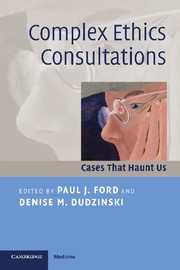Book contents
- Frontmatter
- Contents
- List of contributors
- Foreword
- Acknowledgments
- Introduction: Live and learn: courage, honesty, and vulnerability
- Part I Starting at the beginning: prenatal and neonatal issues
- Part II The most vulnerable of us: pediatrics
- 5 She was the life of the party
- 6 The sound of chains
- 7 Susie's voice
- 8 Access to an infant's family: lingering effects of not talking with parents
- Part III Diversity of desires and limits of liberty: psychiatric and psychological issues
- Part IV Withholding therapy with a twist
- Part V The unspeakable/unassailable: religious and cultural beliefs
- Part VI Human guinea pigs and miracles: clinical innovations and unorthodox treatment
- Part VII The big picture: organizational issues
- Conclusions, educational activities, and references
- Index
7 - Susie's voice
Published online by Cambridge University Press: 03 May 2010
- Frontmatter
- Contents
- List of contributors
- Foreword
- Acknowledgments
- Introduction: Live and learn: courage, honesty, and vulnerability
- Part I Starting at the beginning: prenatal and neonatal issues
- Part II The most vulnerable of us: pediatrics
- 5 She was the life of the party
- 6 The sound of chains
- 7 Susie's voice
- 8 Access to an infant's family: lingering effects of not talking with parents
- Part III Diversity of desires and limits of liberty: psychiatric and psychological issues
- Part IV Withholding therapy with a twist
- Part V The unspeakable/unassailable: religious and cultural beliefs
- Part VI Human guinea pigs and miracles: clinical innovations and unorthodox treatment
- Part VII The big picture: organizational issues
- Conclusions, educational activities, and references
- Index
Summary
Case narrative
Late one summer, a 9-year-old girl, Susie, complained of a headache and sore throat. Her parents took her to the pediatrician, who diagnosed her with strep throat and swimmer's ear and prescribed an antibiotic. Several days later, Susie was taken back to the doctor because the earache persisted. When she developed a dangerously high fever, her parents took her to a local emergency room where she was diagnosed with mastoiditis. To treat this condition, two intravenous antiinfection drugs were administered and a drainage wick was placed in her ear. She was then transported to the children's hospital for further evaluation. This was one week after her initial visit to her pediatrician. The evaluation at the children's hospital documented that Susie had been nauseated and had experienced night sweats and pain in her lower extremities. She had frequent bruises on her legs and was lethargic. A physical exam uncovered tender swelling around her right ear, and a complete battery of blood tests revealed T-cell acute lymphoblastic leukemia (ALL).
After Susie was diagnosed, her parents consented to chemotherapy treatment following the National Childhood Cancer Foundation CCG Protocol 1952, part of an ongoing pediatric oncology treatment study. The study was designed to test the benefits of substituting certain medications from previous CCG protocols and of administering a triple rather than single intrathecal therapy (injecting chemotherapy directly into the cerebrospinal fluid using lumbar puncture). The study is also designed to measure relapse rates. Based on national averages, Susie's chance of cure was approximately 85%.
- Type
- Chapter
- Information
- Complex Ethics ConsultationsCases that Haunt Us, pp. 59 - 65Publisher: Cambridge University PressPrint publication year: 2008



